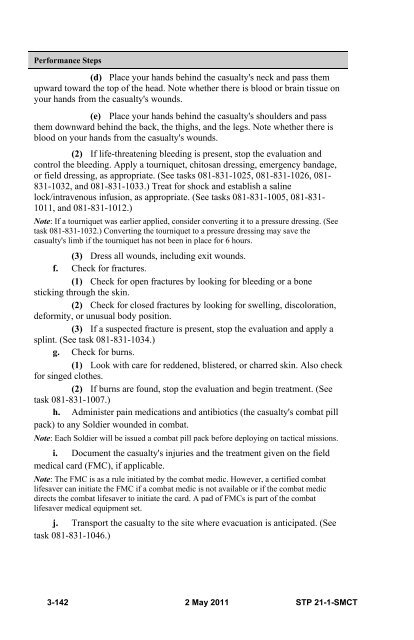Warrior Skills Level 1 - Leader Development for Army Professionals
Warrior Skills Level 1 - Leader Development for Army Professionals
Warrior Skills Level 1 - Leader Development for Army Professionals
You also want an ePaper? Increase the reach of your titles
YUMPU automatically turns print PDFs into web optimized ePapers that Google loves.
Per<strong>for</strong>mance Steps<br />
(d) Place your hands behind the casualty's neck and pass them<br />
upward toward the top of the head. Note whether there is blood or brain tissue on<br />
your hands from the casualty's wounds.<br />
(e) Place your hands behind the casualty's shoulders and pass<br />
them downward behind the back, the thighs, and the legs. Note whether there is<br />
blood on your hands from the casualty's wounds.<br />
(2) If life-threatening bleeding is present, stop the evaluation and<br />
control the bleeding. Apply a tourniquet, chitosan dressing, emergency bandage,<br />
or field dressing, as appropriate. (See tasks 081-831-1025, 081-831-1026, 081-<br />
831-1032, and 081-831-1033.) Treat <strong>for</strong> shock and establish a saline<br />
lock/intravenous infusion, as appropriate. (See tasks 081-831-1005, 081-831-<br />
1011, and 081-831-1012.)<br />
Note: If a tourniquet was earlier applied, consider converting it to a pressure dressing. (See<br />
task 081-831-1032.) Converting the tourniquet to a pressure dressing may save the<br />
casualty's limb if the tourniquet has not been in place <strong>for</strong> 6 hours.<br />
(3) Dress all wounds, including exit wounds.<br />
f. Check <strong>for</strong> fractures.<br />
(1) Check <strong>for</strong> open fractures by looking <strong>for</strong> bleeding or a bone<br />
sticking through the skin.<br />
(2) Check <strong>for</strong> closed fractures by looking <strong>for</strong> swelling, discoloration,<br />
de<strong>for</strong>mity, or unusual body position.<br />
(3) If a suspected fracture is present, stop the evaluation and apply a<br />
splint. (See task 081-831-1034.)<br />
g. Check <strong>for</strong> burns.<br />
(1) Look with care <strong>for</strong> reddened, blistered, or charred skin. Also check<br />
<strong>for</strong> singed clothes.<br />
(2) If burns are found, stop the evaluation and begin treatment. (See<br />
task 081-831-1007.)<br />
h. Administer pain medications and antibiotics (the casualty's combat pill<br />
pack) to any Soldier wounded in combat.<br />
Note: Each Soldier will be issued a combat pill pack be<strong>for</strong>e deploying on tactical missions.<br />
i. Document the casualty's injuries and the treatment given on the field<br />
medical card (FMC), if applicable.<br />
Note: The FMC is as a rule initiated by the combat medic. However, a certified combat<br />
lifesaver can initiate the FMC if a combat medic is not available or if the combat medic<br />
directs the combat lifesaver to initiate the card. A pad of FMCs is part of the combat<br />
lifesaver medical equipment set.<br />
j. Transport the casualty to the site where evacuation is anticipated. (See<br />
task 081-831-1046.)<br />
3-142 2 May 2011 STP 21-1-SMCT

















